Key Guidelines For Apple Tree Care Shared By Orchard Growers

FRUIT > APPLES

Elizabeth is a Permaculture Garden Designer, Sustainability Consultant and Professional Writer, working as an advocate for positive change. She graduated from the University of St. Andrews with an MA in English and Philosophy and obtained a Diploma in Applied Permaculture Design from the Permaculture Association.
Reviewed By DAN ORI

Dan has over 27 years’ under his belt caring for plants and gardens. Working as a Horticultural Instructor and Consultant, he draws on a diverse range of experience that includes working as a Head Gardener, Tree Surgeon, Garden Centre Trouble Shooter, and writer of academic papers. Dan has a Level 3 Diploma in Horticulture and is currently a candidate for the RHS’s most prestigious award – The Master of Horticulture.
Contributions From JULIE BELLEMANN

Julie and the team strive to do more for the community than just grow trees. Described as a ‘social enterprise tree nursery’, Sheffield Fruit Trees is a not-for-profit organisation that is working towards planting more edible trees across the whole of Sheffield to connect more people to their food.

Tom's nursery specialises in a range of fruits, including apples. The nursery has been certified Organic by the Soil Association and has been featured in The Guardian and The Daily Telegraph for its work.

Naomi Slade is a Gardener, Author and Consultant with 25 years’ experience in writing. Naomi has published several books, presented on mainstream TV shows and written for various gardening publications. In 2022 she won the Garden Media Guild’s Best Practical Journalist Of The Year award.
IN THIS GUIDE
Apple trees are one of the simplest fruit trees to grow in the UK and offer a plethora of benefits to the garden space.
I am lucky enough to have 6 mature apple trees in my forest garden orchard and these trees were one of the things about this property that led us to make it our forever home.
Whether you have space for a single tree in your garden, wish to plant a whole orchard, or want to make an eco-friendly and sustainable forest garden of your own, apple trees can be a great choice.
“If I had to choose a plant I couldn’t live without, it would have to be apple trees because I love my orchard,” shares Garden Writer Naomi Slade.
“The trees are beautiful in blossom and in fruit, the apples are delicious and if you go away for a while they are unlikely to die.”
As well as drawing on personal experience, for our apple tree guides I have collaborated with some experienced fruit tree specialists:
- Julie Bellemann – Co-op Member at Sheffield Fruit Trees
- Tom Adams – Owner of Tom Adams Fruit Tree Nursery
“I’m passionate about growing apples because they represent a local distinctiveness and heritage that is being lost through the dominance of supermarkets and their drive towards monoculturalism,” says Tom.
“I’m passionate about growing food in a way that works with and benefits the local environment and community.”
Overview
| Botanical Name | Malus domestica |
| Common Name(s) | Apple Tree |
| Plant Type | Tree |
| Native Area | Central Asia |
| Hardiness Rating | H6 |
| Foliage | Deciduous |
| Flowers | White or pink blossom |
| Harvesting Months | August-October |
Sunlight
Preferred
Full Sun or Partial Shade
Exposure
Sheltered position recommended to achieve the best flowering / fruit
Size
Height
Varies
Spread
Varies
Bloom Time
Spring
Soil
Preferred
Clay, loam or sand
Moisture
Moist but well-drained
pH
Neutral
Apple trees, Malus domestica, are thought to be hybrids of orchard origin.
“The origin of Malus domestica is still in dispute among academics, however, it is generally agreed that Malus sylvestris and Malus pumila are genetic progenitors,” says Dan Ori, qualified Arborist.1Coart, E., Van Glabeke, S., De Loose, M., Larsen, A. S., & Roldán-Ruiz, I. (2006). Chloroplast diversity in the genus Malus : new insights into the relationship between the European wild apple ( Malus sylvestris (L.) Mill.) and the domesticated apple ( Malus domestica Borkh.). Molecular Ecology, 15(8), 2171–2182. https://doi.org/10.1111/j.1365-294x.2006.02924.x
Apple trees derive from a common root in central Asia, but many different varieties are now found around the world, which, while they share certain things in common, can have extremely diverse characteristics.2Malus domestica. (n.d.). Kew Royal Botanic Gardens. Retrieved March 9, 2023, from https://powo.science.kew.org/taxon/urn:lsid:ipni.org:names:726282-1
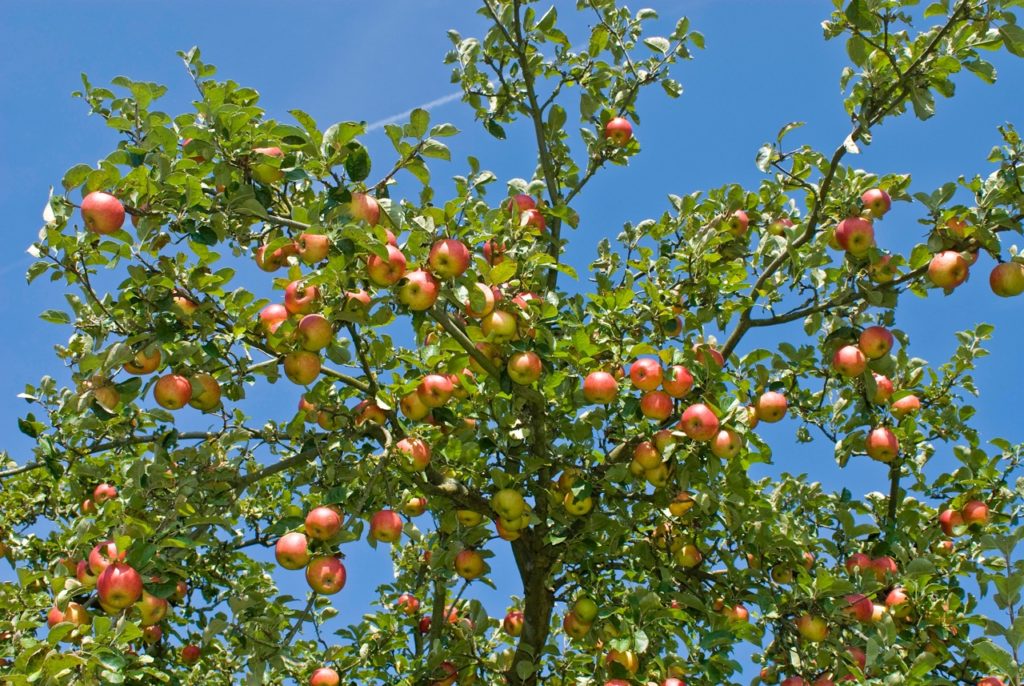
These are deciduous trees that blossom between April and June, fruiting from late summer to the end of autumn.
These trees are easily grown, wildlife-friendly and productive, potentially offering very high yields.
It’s no wonder that they are one of the most commonly cultivated fruit crops in temperate climate zones.
Where To Grow Apple Trees
You can grow an apple tree in an open situation, against a wall or fence or even in a container as long as you choose the right rootstock.
Choosing the right rootstock is important, Dan says, because “they control the vigour of the tree…and ensure you have an appropriate size tree.”
In addition:
- Rootstocks and cuttings give you a true clone of the desired plant, seeds do not.
- Rootstocks can be used to grow on a soil type that might normally be difficult if the plant was growing on its own roots.
- Rootstocks can be selected to improve disease resistance.
It is therefore incredibly important that you match the conditions available to you with the right rootstock.
Another of the most important things to think about when choosing where to grow an apple tree are light levels and the soil.
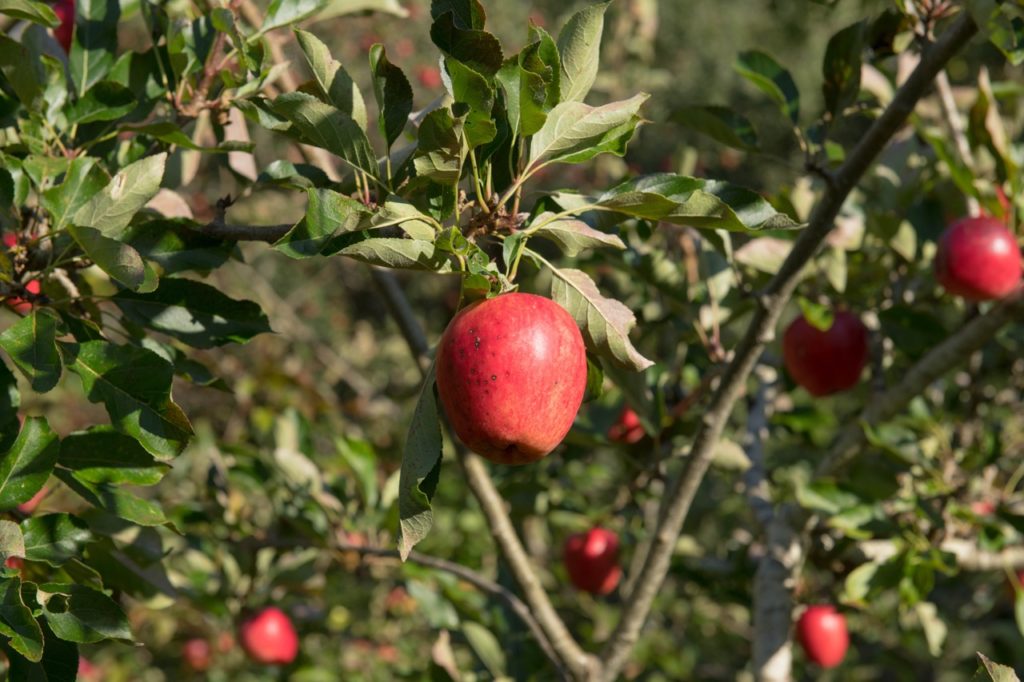
For best fruit production, it is also worth noting that an apple tree should be exposed to around 1,000 hours of temperatures below 7°C in winter, at least 6-8cm of rainfall per year and reasonably warm summer temperatures.
When choosing where to place an apple tree, it is important to offer it protection from late spring frosts and cold winds, especially those from the north and east.
Suitable conditions for apple trees are pretty easy to provide in most of the UK.
However, it is important to understand that choosing the right apple tree for where you live will be key to obtaining good yields.
Choosing Your Apple Type
Some apple tree varieties will thrive in southern areas, while others can cope with cooler and wetter conditions and will be better suited to more northern sites.
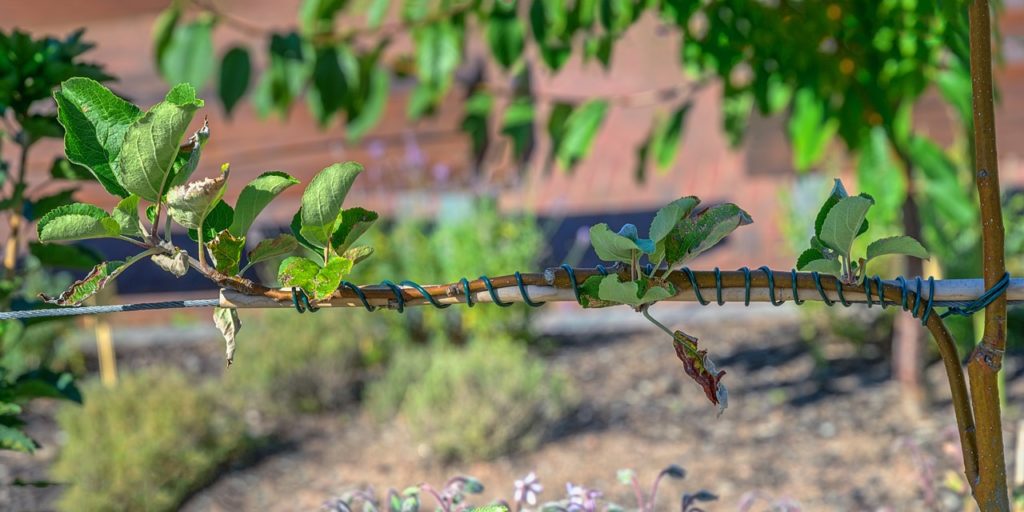
When choosing an apple tree, it is important to consider:
- The rootstock that is chosen, as well as the named variety.
- Environmental needs of the variety in question.
- Pollination requirements.
- The properties of the fruit.
“Make sure that you are choosing the right varieties and rootstocks for your situation,” says Tom.
Thinking about the above will help you find an apple tree that can be grown in your own particular garden and that will meet your own requirements and desires.
Planting Apple Trees
Once you have chosen an apple tree variety to grow, there are 2 ways that you can purchase it.
You can buy an apple tree as a bare-root plant (the cheaper option) or purchase a pot-grown specimen.
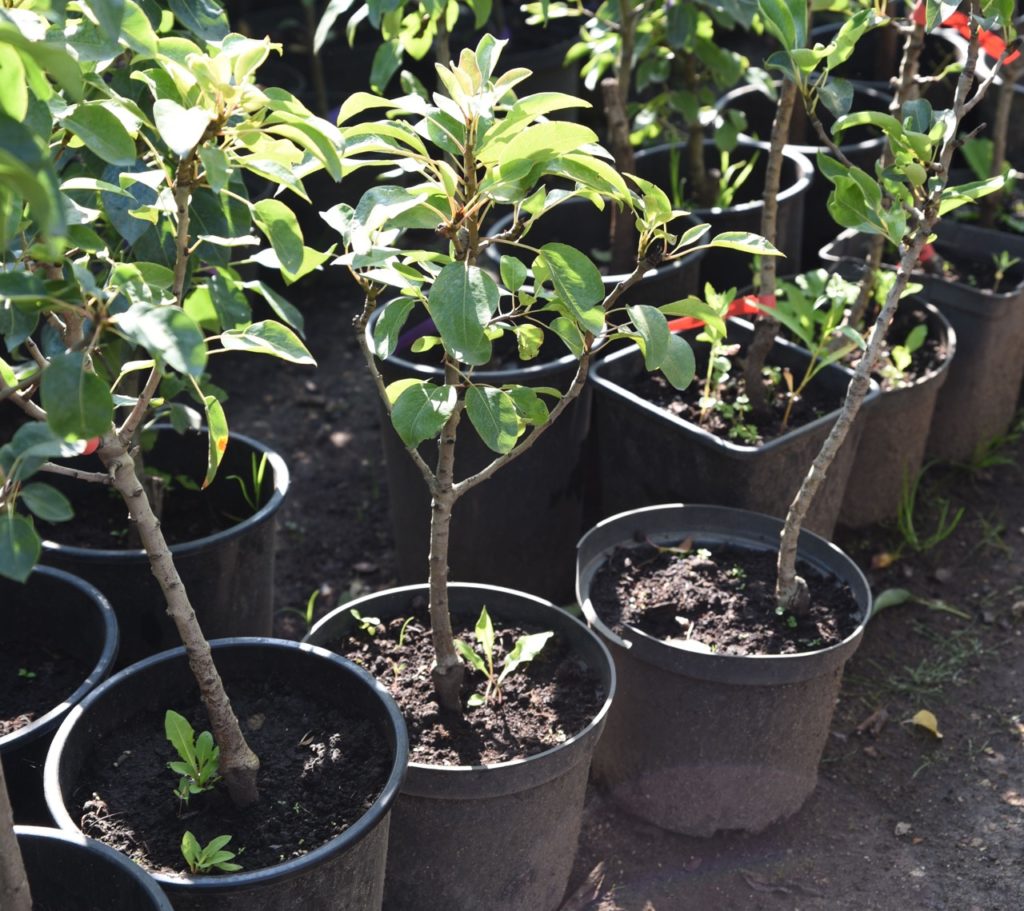
Bare-root apple trees are planted during the dormant period, between November and March.
Pot-grown trees can be planted at any time, but are also ideally planted during the winter months, as this is when they stand the best chance of establishing successfully where they are to grow.
How To Plant
Choose an appropriate location for the apple tree you have chosen.
“It’s always a good idea to grow your apple trees in a diverse habitat to encourage predators and pollinating insects,” Tom says.
Arborists used to advise 20-30 years ago that you dig a hole as deep as the roots of the apple tree you are planting and 3 times the diameter of the existing root system.
However, “consensus among experts [nowadays] is to dig a hole the same depth and just slightly wider than the existing roots,” recommends Dan Ori.
“[My] top tip – digging a square hole should produce better roots and a healthier tree; as the tree roots spread and hit the solid face of a square hole they are more likely to penetrate it and spread, rather than curl around the edge which could happen with a round planting hole”.
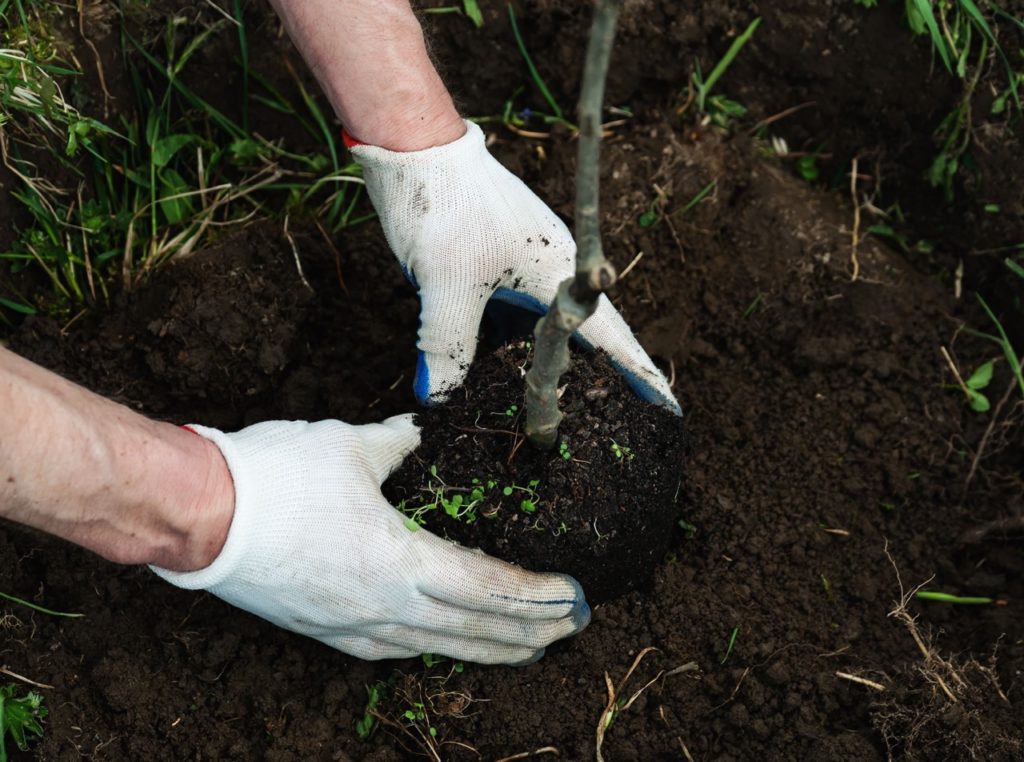
Place the tree into the hole, spreading out the roots as you go, and make sure the tree is at the same level in the soil and is standing upright.
Carefully firm the soil back around the roots, tamping it into place gently but firmly.
Water the tree and add an organic mulch around, but not touching, the trunk of the tree.
Apple Tree Care
Light
Apple trees grow and fruit best in a spot in full sun.
Eating apples or dessert apples tend to need a sunny spot for the best ripening and flavour, whilst some tarter cooking and crab apples can be more tolerant of a partially shaded spot.
Soil Requirements
These fruit trees are more tolerant of soil type and conditions than many other fruit trees that might be grown in the UK and can do well in almost any fertile soil.
However, they will do best where there is moist yet well-drained loamy soil, rich in organic matter.
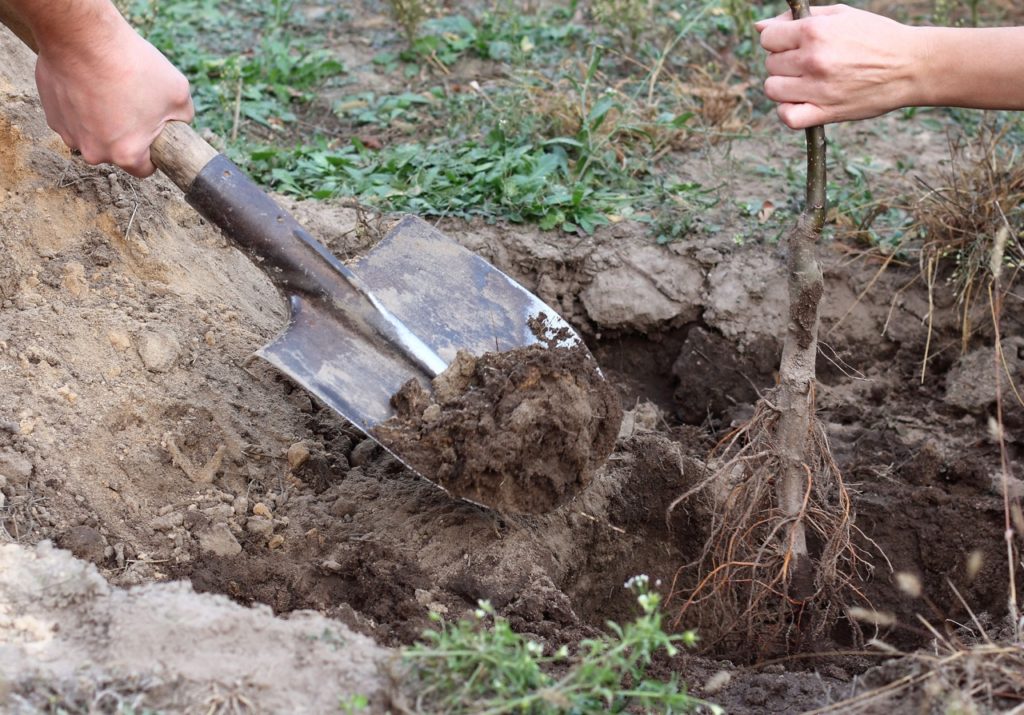
“Heavy and waterlogged soils should be avoided as apple tree roots will struggle to access essential nutrients in wet heavy soils,” advises Dan.
“This poor nutrient uptake is due to anaerobic soil conditions and this, in turn, will potentially be causing poor tree health and susceptibility to disease.”
The ideal soil will have a pH that is neutral, but it can tolerate higher or lower levels of soil acidity.
Watering
Once established, apple trees in the ground will typically only require watering during extremely dry periods.
However, as young trees become established, they will need to be watered more frequently.
Water well, but make sure excess water can drain away.
Companion Planting
You can ensure the health of an apple tree and improve yields if you plant a guild of companion plants around it.

In an apple tree guild, we should place plants that offer benefits to the apple tree without increasing competition too much.
We will often typically include:
- Dynamic accumulator plants that take nutrients from deep below the soil surface or which are good at gathering particular nutrients, and make them available in upper layers of the soil for the apple tree to use. These may also be chopped and dropped as mulch around the tree.
- Nitrogen-fixing plants that can cooperate with bacteria to replenish nitrogen in the soil.
- Attractant plants that bring in pollinators and other beneficial wildlife.
- Repelling plants that help an apple tree by distracting, confusing or repelling certain pests.
- Ground cover plants that protect the soil, conserve moisture and suppress weeds.
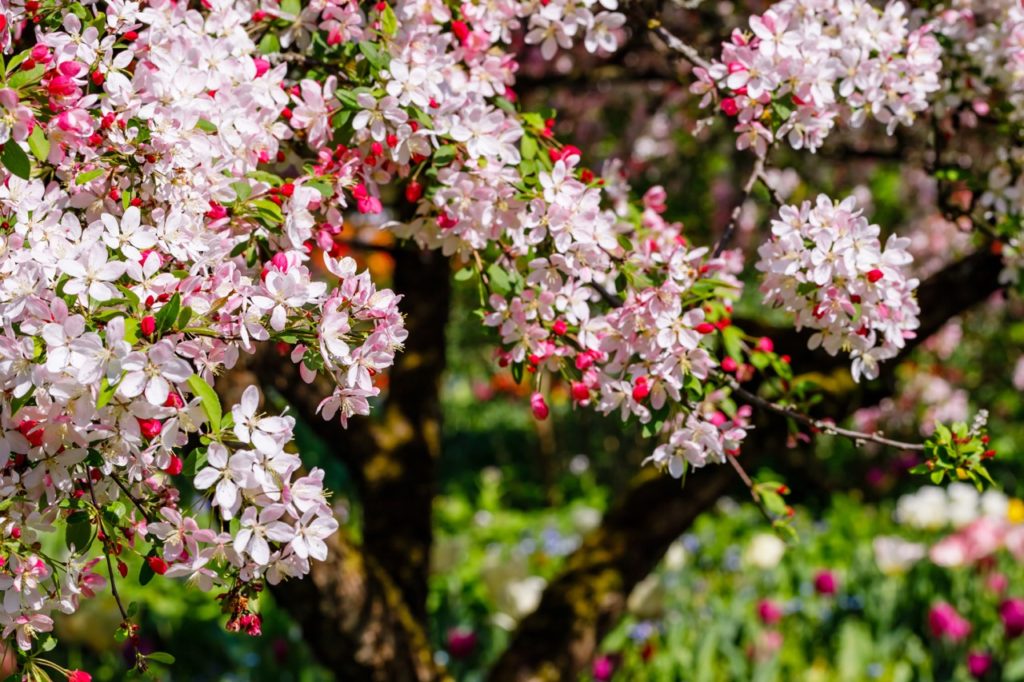
Some plants can fall into more than one of these categories and are therefore great companion plants to place surrounding an apple tree.
Some great companion plants for apple trees are:
- Comfrey – dynamic accumulator, attractant plant.
- Yarrow – dynamic accumulator, attractant plant.
- Borage – dynamic accumulator, attractant plant.
- White Clover – nitrogen fixer, attractant plant, ground cover plant.
- Mint – pest repellent, ground cover plant.
- Woodland Strawberries – attractant plant, ground cover plant.
- Daffodils (or other spring bulbs) – attractant, suppresses grass growth into guild area.

Of course, these are just a few examples.
Propagation
Apple tree propagation is typically not an activity for beginners, as grafting is usually involved.
Growth Timelines
How Long Does An Apple Tree Take To Grow?
It can take 2-6 years (depending on a number of factors) for an apple tree to start bearing fruit.
“You can expect the first fruit on dwarf M27 rootstock from 2 years and vigorous M25 rootstocks from 5-6 years,” says Dan.
“Large trees can take decades to reach their ultimate size and dwarf trees may reach their ultimate height in 3-10 years.”
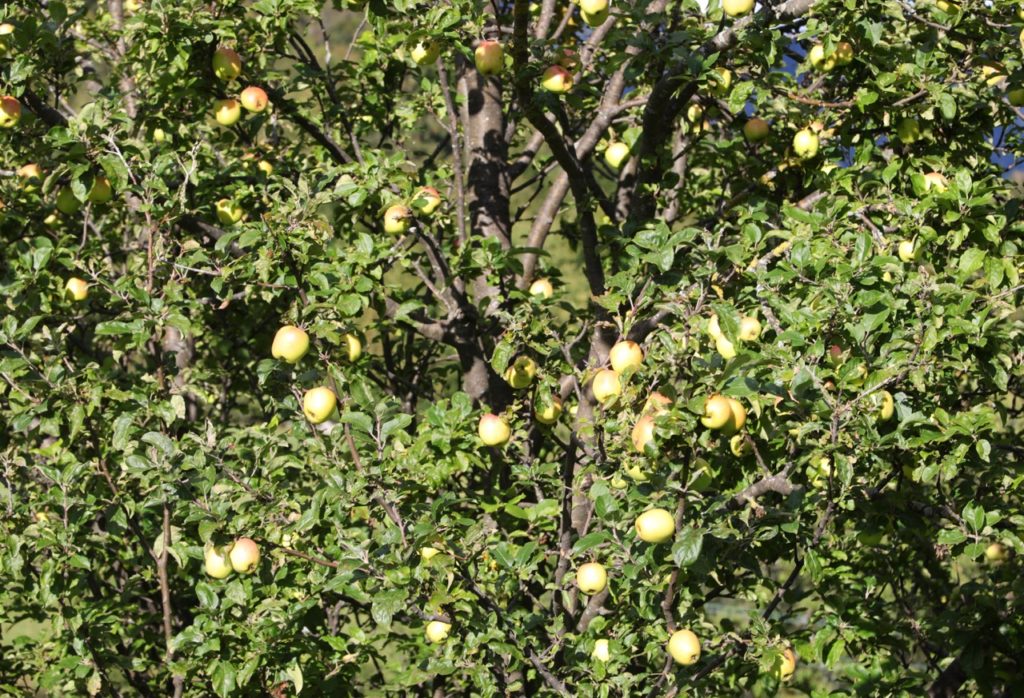
The time it takes an apple tree to mature and reach its optimal size can also vary greatly depending on the variety and rootstock chosen.
And How Long Do They Typically Live For?
Apple trees generally live for between 20-50 years, but this is a number that can vary dramatically, depending on various factors such as the cultivar and its growing conditions.
They will typically have a productive fruiting life of 12-50 years, according to Arborist Dan Ori.
“Most UK commercial apple trees grown for fruit are the M9 rootstock, these become less productive after 12 years, and are almost always pulled up and planted with new trees.
“But don’t worry if you have an M9 at home, you will still get plenty of fruit past 12 years.”
References
- 1Coart, E., Van Glabeke, S., De Loose, M., Larsen, A. S., & Roldán-Ruiz, I. (2006). Chloroplast diversity in the genus Malus : new insights into the relationship between the European wild apple ( Malus sylvestris (L.) Mill.) and the domesticated apple ( Malus domestica Borkh.). Molecular Ecology, 15(8), 2171–2182. https://doi.org/10.1111/j.1365-294x.2006.02924.x
- 2Malus domestica. (n.d.). Kew Royal Botanic Gardens. Retrieved March 9, 2023, from https://powo.science.kew.org/taxon/urn:lsid:ipni.org:names:726282-1
